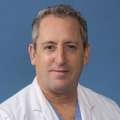Stroke
The UCLA Stroke and Vascular Neurology Program performs major interdisciplinary clinical and basic research studies of cerebrovascular disease. Stroke program members collectively have hold over 20 NIH-NINDS cerebrovascular research grants, as well as multiple grants from the American Stroke Association, American Heart Association and the National Stroke Association. The UCLA Stroke Program administers an extensive clinical trial program at over 40 hospitals in West Los Angeles, encompassing at any one time 5-10 Phase II and Phase III trials of neuroprotective, antithrombotic, thrombolytic, and mechanical endovascular treatment strategies.
Selected major research advances from the UCLA Stroke Program
- First validated tool enabling paramedic recognition of stroke:
The Los Angeles Prehospital Stroke Screen (LAPSS). Now part of the curriculum of advanced life support training for paramedics worldwide - First prehospital neuroprotective treatment of stroke:
UCLA physicians and LA paramedics were the first to give a potentially brainsaving drug to patients in the ambulance, prior to hospital arrival. In the UCLA FAST-MAG Pilot Trial, starting the drug in the ambulance accelerated the start of therapy by 2 hours - First demonstration of reversal of advanced stroke injury in humans by rapid reopening of blocked arteries:
Using sophisticated brain imaging, UCLA researchers demonstrated that reopening blocked arteries soon after stroke onset can salvage brain regions with advanced bioenergetic failure - First delineation of the amount of brain circuitry lost in acute stroke:
UCLA researchers demonstrated that the brain loses 2 million nerve cells and 14 billion nerve connections every minute in which treatment does not occur. This finding provided quantitative grounding for the national "time lost is brain lost" campaign to increase public awareness of stroke symptoms and the importance of calling 911 - First device to remove clots from blocked arteries in acute stroke:
The Merci retriever clot retrieval device is a long thin tube with a corkscrew shaped tip that is used to grab clots that are blocking arteries and pull them out of the body. This restores blood flow to the threatened brain. The Merci retriever is the first FDA approved device for use in acute stroke and was invented and developed at UCLA - First device to obliterate brain aneurysms:
The GDC coil allows thin walled brain aneurysms to be packed and closed through a minimally invasive technique, removing the chance that they will rupture and cause brain hemorrhage, coma, and death. This first device to treat brain aneurysms was invented and developed by the interventional neuroradiology UCLA. - First systematic secondary prevention program for cerebral atherosclerosis:
Plaque buildup in arteries going to the brain is the leading cause of stroke. Seventy-five percent of these strokes can be prevented by known treatments, but these are unfortunately often not given to stroke patients. UCLA developed the Stroke PROTECT program for ensuring delivery of proven therapies to all patients, which became a national model for quality improvement programs nationally
Selected major research advances from the UCLA Stroke Program
- Treating patients FAST, in the field:
UCLA is conducting the first large trial of prehospital treatment of stroke ever conducted. In the NIH-funded Field Administration of Stroke Therapy-Magnesium (FAST-MAG) Trial, 2000 paramedics in Los Angeles are starting the neuroprotective drug magnesium sulfate or placebo in the ambulance in 1298 stroke patients. This is the first trial to treat patients in the "golden hour," the first 60 minutes after stroke onset when virtually all threatened brain tissue is still salvageable - New clot-busters:
Current clot busting drugs help many patients by opening blocked arteries and restoring blood flow, but sometimes harm patients by causing bleeding into the brain. UCLA is developing a new clot-busting agent, plasmin, which can be fine-tuned to optimize beneficial blood vessel reopening while avoiding bleeding side effects - Crossing the barrier:
The blood brain barrier normally keeps drugs from crossing from the circulation into the brain. Many promising drugs have failed to work in acute stroke because they could not cross from the blood to the brain fast enough to be active while there was still brain to save. UCLA researchers have designed a "Trojan horse" drug that overcomes this challenge. It consists of a chaperone molecule that crosses the blood brain barrier easily and a neuroprotective molecule highly effective at preserving nerve cells. UCLA will soon be conducting the first in humans testing of this revolutionary strategy for treating acute stroke. - Using a tissue clock, not a time clock:
While some patients with acute ischemic stroke experience rapid death of all threatened nerve cells within 1-2 hours, others still have salvageable tissue 6-12 hours after onset. UCLA researchers are leading a pathbreaking clinical trial that uses novel magnetic resonance brain imaging to determine precisely how much brain is still salvageable in each patient and select patients for therapy to reopen blocked arteries as late as 8 hours after stroke onset. - Plugging holes in hearts:
One quarter of individuals have a patent foramen ovale (PFO), an opening between the right and left upper chambers of the heart that allows blood clots to more easily reach the brain. UCLA researchers are leading a national trial of a novel button device that is deposited in the heart by a catheter to close this opening and reduce the risk of new strokes.
Director
Faculty
Giving: Your gift to the UCLA Stroke program makes a difference.





